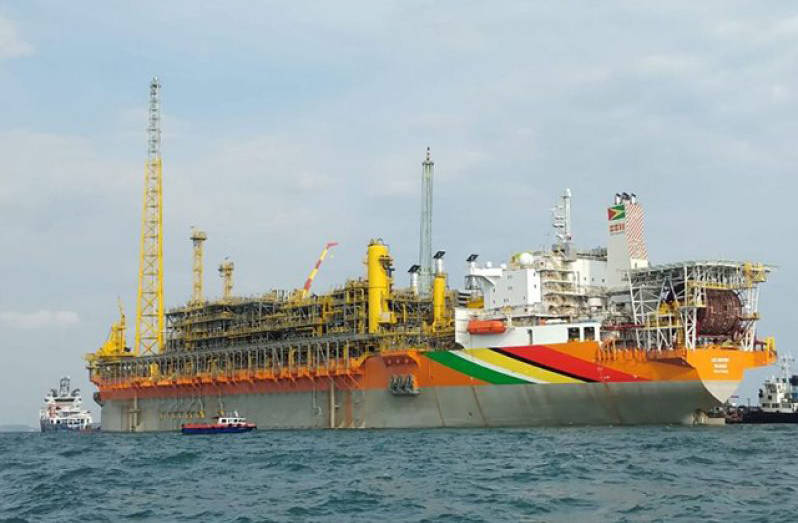–country’s total revenue to increase by 17 per cent
COMING on the heels of the successes recorded in the latter part of 2020, a year plagued by a dreaded pandemic and protracted electoral process, is another positive outlook for Guyana, as the country’s total revenue is expected to increase by 17 per cent, with earnings in the petroleum sector alone reaching over US$500 million by the end of this year.
The Inter-American Development Bank (IDB), in its Caribbean Quarterly Bulletin which was released on Monday, stated that with Brent crude oil – the index Guyana uses to sell its crude – at more than US$60 a barrel and the expectation of oil production increasing by 46.7 per cent in 2021, the government’s oil revenues could significantly increase this year.
For medium-term projections, the International Monetary Fund (IMF), as cited by the IDB, assumed an average price of oil of US$58.52 per barrel in 2021 and US$54.83 per barrel in 2022, with the price remaining unchanged in real terms thereafter.
Having already earned US$267 million from the sale of oil and royalty payments through 2020 and March 2021, Guyana’s balance at the end of this year could reach over US$500 million.
Revenue aside, driven mainly by a projected increase of 46.7 per cent in oil production, from 74,300 barrels per day in 2020 to 109,000 in 2021, Guyana’s Gross Domestic Product (GDP) is estimated to grow by 20.9 per cent this year, according to the IDB.
As noted in a previous edition of the IDB’s Quarterly Bulletin, the GDP shock in 2020 represented the largest decline in most countries since 1975. However, Guyana was the one exception.
The decline in average oil prices during the year did lower the expected value of oil exports and hence the expected GDP growth rate. Still, the local economy expanded by 43.5 per cent in 2020, while the non-oil economy shrank by 7.3 per cent.
In 2020, when the country recorded unprecedented GDP growth, the main driver of advancement was oil production, which represented 37 per cent of GDP and accounted for 51 per cent of overall GDP growth.
Over the medium term, according to the IDB, oil production is expected to continue driving GDP growth, with oil exports growing by an annual average of 48.5 per cent over 2020–2023, contributing to average annual GDP and Government revenue growth rates of 17.1 and 6.7 per cent, respectively, from 2021 to 2026.
PROSPECTS EVEN BRIGHTER
The prospects are even brighter given that ExxonMobil, on April 27, announced their 19th oil discovery in Guyana and increased the estimate of recoverable petroleum resources from eight billion to nine billion oil-equivalent barrels, an estimate that had not been adjusted since January 2020.
Additionally, ExxonMobil updated its development plans of having five oil production projects by 2026 to six projects by 2027, which they see could potentially grow to ten production projects in the future.
Progress in the petroleum sector will be supplemented by advancements in other sectors; this is reflected in the projections for the country’s non-oil economy, which is expected to rebound by 6.1 per cent in 2021 based on the assumption of a phased re-opening of the economy, with services and construction growing by five per cent and nine per cent, respectively.
As the wheel continues to turn across the economic sectors, the country could see an increase of 17 per cent in total revenue, moving from US$1 billion in 2020 to US$1.3 billion in 2021. In 2020, revenue fell by 5.5 per cent as a result of reduced economic activities and a series of tax exemptions in specific sectors. On the other hand, expenditure grew by 15 per cent.
According to the IDB, total expenditure is projected to increase by 13 per cent this year, moving from US$1.5 billion to US$1.7 billion. Government expenditures are estimated to grow by an average of 5.3 percent over 2021-2026, contributing to a fall in the fiscal deficit from 7.4 per cent in 2020 to 3.4 per cent in 2026.
The year 2021, according to President, Dr. Irfaan Ali, will be the springboard from which Guyana will leap into recovery, rebuilding the economy, enhancing the people’s health and lifting up the vulnerable in groups in society.
“We must not remain a rich country of poor people,” the President had affirmed, noting that the bounty of Guyana must be shared across the population.




.png)









